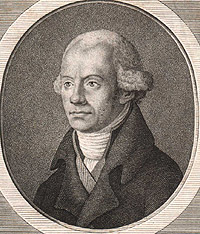Franz Joseph Gall
From Psy3242
Contents |
Overview
Franz Joseph Gall (1758-1828) was a German neuroanatomist, influential in his championing of a neurological model based on the localization of brain functions. He is also well-known for creating the pseudoscience of "craniology" (from the Latin cranium "skull" and scopos "vision"), the basis for what would become known as "phrenology", a term coined by Gall's ardent follower, Johann Spurzheim. In this (unscientific) theory, the contours of the skull are supposed to be accurate indicators of one's personality. However, Gall was also responsible for advocating the (then) revolutionary idea that the brain and not the heart, is the location where mental functioning occurs. With his student, Spurzheim, he made "many important discoveries about the anatomy of the brain, its connections with the spinal cord, and its ability to control muscles" (Stirling 4).
Portrait of Franz Joseph Gall
More About Phrenology
Gall and Spurzheim believed that brain was composed of twenty-seven distinct compartments, each of which was responsible for a different type of "brain functioning", such as language, hope, self-esteem and combativeness. Gall proposed that the areas that were used more often would cause the brain to grow bigger in that area, and thus, the skull would have to grow and expand upwards from that area in order to accommodate the new brain tissue. Thus, by "reading" the bumps on a person's skull, it was believed that someone skilled in cranial analysis could determine to what kind of person the skull belonged. Over time, however, it was observed that the shape of the skull actually had little to do with the shape of the brain beneath it. It was the French researcher Pierre Flourens who began to discredit Gall's theories, by noting that, when creating lesions and ablations, the amount of damage appeared to have a greater effect on resulting function than the location of the damage, and that it was probable that undamaged areas of the brain could help take over the functioning of damaged ones. While this new thought would help to pave the way for the concept of neural plasticity, and helped to disprove phrenology as a scientific study, Flourens' own ideas are now thought to be mostly incorrect. Stirling gives three crucial reasons to question his findings, the first being that Flourens almost always used chickens and pigeons in his studies, creatures which we now know have almost no cortex. Also, he judged degrees of impairment by observing behaviors (such as eating and movement) that were not related to Gall's twenty-seven "brain areas". Lastly, Flourens' surgical procedure was "imprecise" (he was working in nineteenth century, after all), and as such, unforeseen and unaccounted for damage could have occurred in the studies to further detract from their validity.
Interesting Trivia
- If you ever find yourself traveling to the cozy town of Baden bei Wien, Austria, the Rollet Museum located there houses a collection of the skulls Gall examined in his studies.
- Gall's father was a wealthy Roman Catholic wool merchant, and had intended for his son to enter the priesthood.
- Franz Gall is credited with giving the first full account of aphasia in connection with brain damage (6).
- Jean Pierre Flourens, the man who first scientifically questioned Gall's theories, would later become a pioneer in the study of anesthesia (specifically chloroform).
Sources
Stirling, John. Introducing Neuropsychology. New York: Psychology Press, 2002.
Wikipedia

